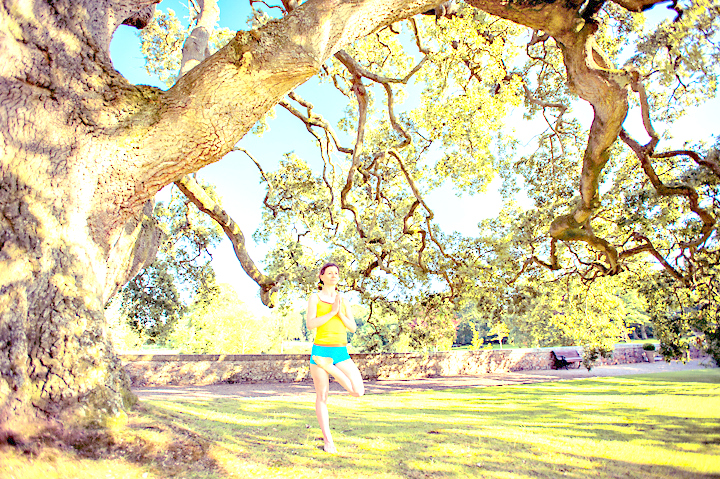Remember from Part I that we are focussing in on how you can apply Yoga ethics when you are at Yoga school and on your mat. The ‘Yamas’ are universal principles aimed at destroying our lower nature; there are five of them:
- Ahimsa ~ Non-violence, Non-harming (think Ghandi!)
Not just in relation to your fellow humans but also towards YOURSELF. Not just physical violence towards oneself but also mental violence.
This starts really with respecting yourSelf. Leave ‘forcing’ and the mindset of ‘no pain no gain’ outside the Yoga room. It might work or pay dividends for you in the world/workplace outside (long term does it really, mmmmm) but it has no place on your mat i.e. apply those workplace principles in the Yoga room to your body and you are setting yourself up for injury.
STOP browbeating yourself, chastising, measuring, judging yourself through every class. Yes you are a hard worker in the world out there but you do not have to prove ANYthing in the Yoga room. In your Yogasana practice think work ‘SMART’ (and I am not talking the well known goal setting acronym here but the informal adjective sense of the word).
- Satya ~ Truthfulness and Wisdom
Again, not just towards others; start with being honest with yourSelf. In word, thought and deed. If you are exploiting an ability in your body to achieve a ‘finish’, if you are persistently taking a path of least resistance (not aligning properly), if you are continually taking risks, if you are allowing yourself to go into territory that is ‘out of control’, if you are ‘muscling’ into postures, if you are skipping parts of the order of events that achieve Asana you are not practicing with honesty and wisdom. Simples.
- Bramacharya ~ Celibacy? 🙂 Avoiding unnecessary expenditure of energy
Well. What can I say. I don’t want to be controversial here. TRADITIONALLY it means celibacy. That is a bit of a head spin for many if they are new to Yoga. There they are reading through the Yamas, thinking ok, I get that, I can work with that and then they hit ‘Bramacharya = Celibacy’!! WHAT NO SEX! Don’t worry folks! We will break this down further in a minute. Put celibacy, which is an abstinence, aside for a moment, let us think behaviours – no doubt instinctual sexual energy is a force to be reckoned with. The strongest checks and balances should be made on this front in an environment where people may feel vulnerable (for both students AND teachers). Neither sex should exploit such an energy arising and self restraint on that front is a must. If in doubt your best check? is probably to discuss it with a reasonable person. Your balance? Never put yourself in a situation where you are alone with the person in question. Modesty too is always a good thing in a Yoga class {Read Oh What to Wear to Yoga!}.
If we break it down further to find another ‘hue’ to this for ‘Yoga studio/mat’ purposes? Think! Too much of anything is not a good thing. It starts with honouring yourSelf. In Yogasana practice you must pace yourself and check how you apportion your energy so that it is not wasted. Leave out the extras, the excessive wiping of sweat and rearranging of clothing/towels and leave out the flourishes {Read Don’t Nourish the Flourish}. Don’t over-analyse in the moment (waste of mental energy). In class it is clear that some postures are more dynamic than others so it would not make sense to approach them all in the same way (something it took me years to work out as I launched myself at each Asana and through each class for the longest time ~ possibly a reflection on how I approached ‘living’ in those days, possibly not). You must cultivate your muscle efficiencies in your practice and save your precious prana for where it is needed most. Asteya (see next Yama) is key to achieving Brahmacharya in your practice. Consider yourself to be ‘mastering’ the right use of your energy in your practice and you will be freeing up your vital energy to find your true potential.
- Asteya ~ Non-stealing
It is not just about not stealing physical items or not stealing other peoples’ time, energy and space. Try not cheating yourSelf. If you are not working smart then it is possible that some muscles or regions in your body are doing the work that is intended/or better done by another! That is a form of stealing. E.g. if you exploit a particularly flexibility in your body to achieve a pose you might be putting joints at risk if there is weight/holding involved. Your Yoga instructor will see this and know that you cannot honestly claim completion of that pose. An example of this I see regularly in class is in Bikram’s Tree, where people try to force a sideward bend of the flexed knee and an excessive turn of the ankle on that leg (exploiting the flexibility in these joints) to achieve posture (half lotus) where they have not employed or tried to work on hip flexibility. Stealing from your ankle and your knee. Reasons this might be?: they just haven’t gone through the full order of events to achieve pose (think Satya), they are just not listening to the detail of the verbal instruction and instead are homing in on the visual of what other people are doing and trying to re-create in their own body, they hit a bit of resistance and try to circumvent it, just not grasping that the resistance is where their Yoga work is to be done, they do not have adequate hip flexibility yet and haven’t exercised patience (think Aparigraha next Yama)). Remember!!! It is your right approach and set up, not the final position, that makes your posture therapeutic AND. SAFE.
- Aparigraha ~ Non-greed, Leg go of Ego, Non-attachment
It is time to FREE yourSelf. Ego has its place in this world and in this work we do (don’t get it confused with arrogance) but excessive Ego is best left outside the door of your Yoga classroom. Constantly comparing yourself to others can work either of two ways. It can demotivate you totally or trigger a competitive nature which can put you at risk in your practice. Continuously kowtowing to excessive Ego will ultimately limit your progress. One might not acknowledge Ego as being dominant for the longest time at the outset of your practice but when you do you will suddenly realise its affect on your practice and on you mentally and physically during class and then you will realise its subsequent affect on the results of your efforts.
Don’t hold on to a way of doing things just because you did it that way before {Read How to be a Yoga Student…. or Let go or be dragged}. Let go of Ego and you might be making space for something truly wonderful. A new way of ‘being’ in your practice and in the world. Avoiding the challenge of creating right action only serves to hold back your practice, development and growth. Have no expectations and you will never be disappointed in your practice. Careful though! Don’t get hung up on being ‘perfect’ in your detachment either; in itself this is an Ego thing.
Using Satya in Aparigraha you must summon up as much honesty in yourself to consider your intentions and what is behind this particular challenge in your practice / body / class and WHY you are so attached to handling it in a same particular way continually (using same poor technique over and over again expecting different results perhaps? O-O).
THIS is where your real Yoga practice becomes a ‘head’ not a ‘physical’ thing! Are you driven by the needs of your ego; therefore feeding it, which is what it thrives on? If your ego is driving you on this trip please pause and remember an ego trip is a journey to nowhere… So DETACH yourself from it as you step onto your mat. Be process driven, not goal driven. Your focus should be on right action in the moment, not on the result of your right action. Practice for the sheer JOY of PRACTICE and not for what it might bring because come what may IT WILL COME ANYWAY!
Om Om Om are you ready for this?
Tune in next time for Part III ~ Niyamas
May 2018

